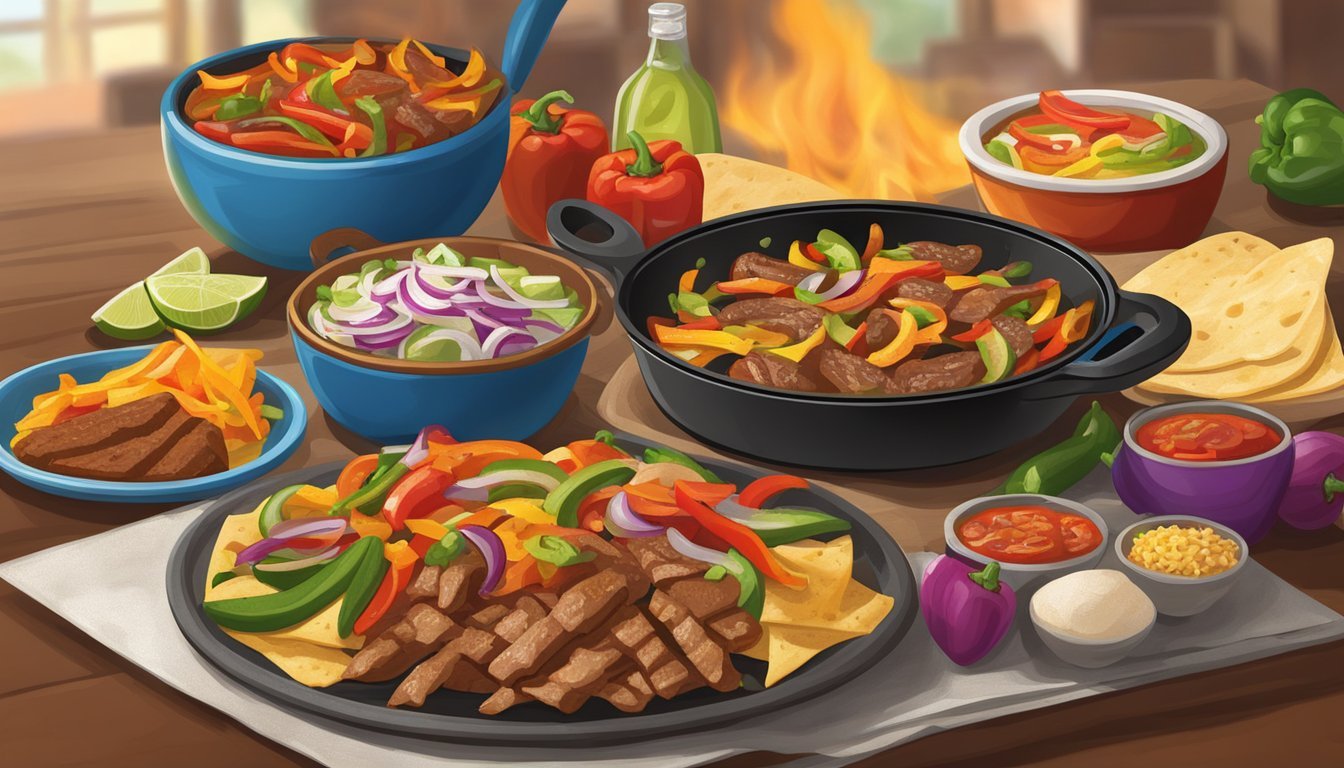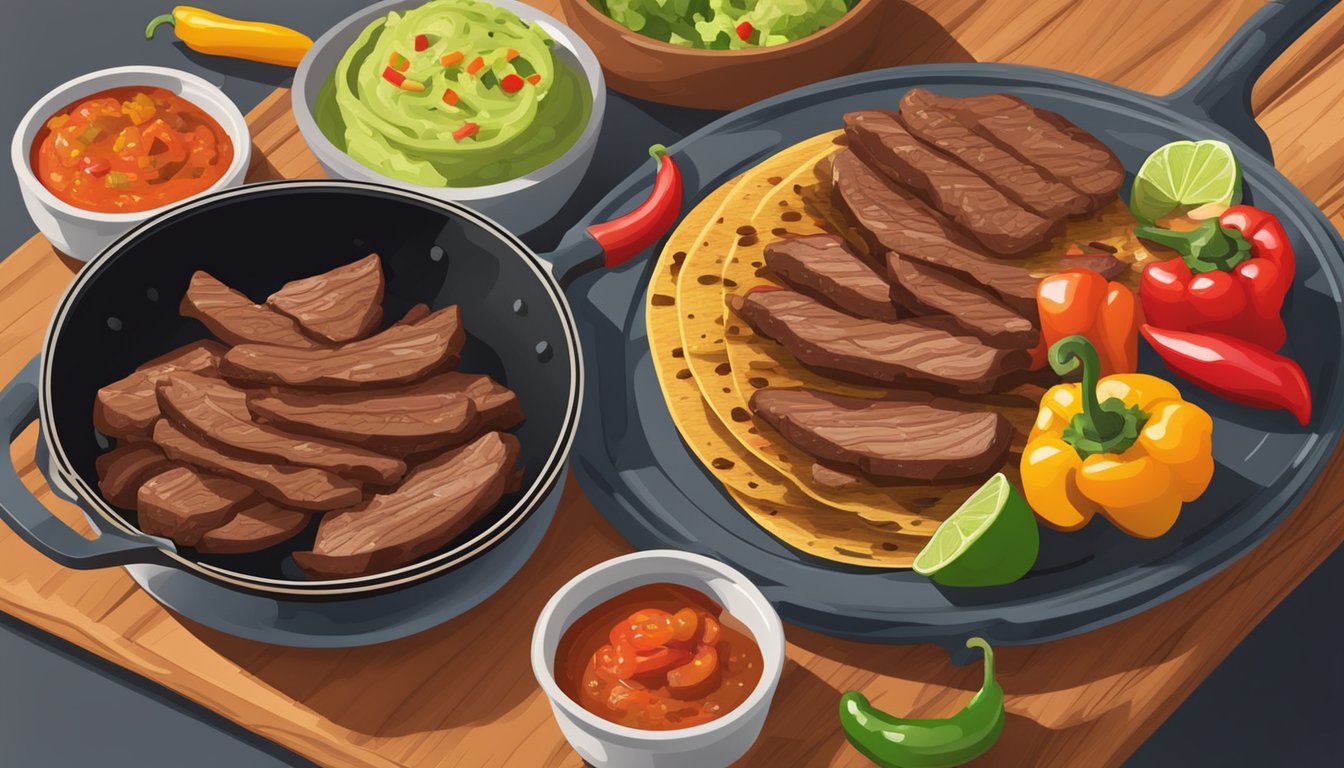Texas Style Fajitas
A Guide to Authentic Flavors and Techniques
Texas-style fajitas embody the hearty and bold flavors characteristic of Tex-Mex cuisine. Traditionally, these fajitas feature marinated grilled meats (What wine goes well with grilled meats?) such as beef, chicken, or shrimp, (What wine goes well with shrimp?) served with a flourish of grilled onions and bell peppers. The marinade, often infused with citrus juices like pineapple or lime, imparts a tenderizing effect on the meats and infuses them with a distinctive zestiness that complements the smokiness from the grill.
The versatility of the fajita recipe allows for various types of meats to be used, with skirt steak being a popular choice for beef fajitas (What wine goes well with beef fajitas?) due to its flavor and texture. For those preferring poultry, chicken is a readily embraced option, often marinated and cooked to juicy perfection. Shrimp adds a seafood twist to the Texas fajita lineup, rounding out the selections for a surf-and-turf experience.
A fajita's assembly is as much a part of the experience as its cooking. Sizzling slices of meat are wrapped in warm, soft flour tortillas and often garnished with a selection of toppings like shredded cheese, sour cream, guacamole, and fresh salsa. This ensemble of flavors and textures makes Texas fajitas a beloved dish for its ability to cater to various tastes while maintaining its unique Southwestern identity.
Historical Background
The evolution of Texas fajitas is a blend of cultural tradition and culinary innovation, primarily attributed to the creativity of Mexican ranch workers in Texas. This section explores the dish's early beginnings and its integration into Tex-Mex cuisine.
Origin of Fajitas
Texas Fajitas have their roots in the Rio Grande Valley in the 1930s. Mexican ranch hands, known as vaqueros, received lesser cuts of beef as part of their wages. They tenderized this meat, typically skirt steak, and cooked it swiftly over an open flame. This method not only made the meat palatable but also maximized its flavor.
Tex-Mex Cuisine
Tex-Mex is a regional American cuisine that blends Mexican and Texan flavors. Fajitas became a staple in this cuisine, as the concept traveled from the ranches to the mainstream marketplace. By 1969, the dish was commercialized in Houston, Texas by Ninfa Laurenzo, often hailed as the matriarch of Tex-Mex fajitas. From then on, fajitas gained popularity, evolving into a beloved dish with various meat options and served typically with grilled onions and bell peppers.
Choosing the Protein
When preparing Texas fajitas, selecting the right protein is crucial for authentic flavor and tenderness. The choice ranges from traditional skirt steak for beef fajitas to versatile chicken and even seafood options like shrimp.
Beef Selection
The most iconic choice is for Texas beef fajitas, specifically skirt steaks. Prized for its robust flavor skirt steak, when cooked correctly, is a tender chew. Flank steak is a suitable alternative, providing a leaner option while still maintaining the characteristic taste and texture expected of a classic fajita.
Chicken and Other Proteins
Chicken breast is a popular alternative for a lighter fajita and should be sliced against the grain to ensure tenderness. Beyond beef and chicken, large shrimp serve as a flavorful seafood option. Whether one opts for beef, chicken, or shrimp, each protein brings its own unique qualities to the dish and must be prepared accordingly to ensure the best results.
Marinating the Protein
Marinating is essential for imparting flavor and helping to tenderize the protein. A basic marinade includes ingredients like lime juice, garlic, and traditional spices that are key to achieving the Tex-Mex essence. For beef, particularly skirt or flank steak, a few hours in the marinade can make a significant difference, whereas chicken and shrimp require less time due to their delicate textures—anywhere from 30 minutes to an hour. It is important to note that marinades containing acidic components such as pineapple juice should not exceed two hours, especially for beef, to avoid over-tenderization.
Preparation Basics
When preparing Texas fajitas, three crucial stages ensure rich flavors and the perfect texture: precise cutting and seasoning, crafting a robust marinade, and mastering grilling techniques.
Cutting and Seasoning
The choice of meat for fajitas typically includes skirt steak or flank steak. For the best results, they should trim excess fat and cut the meat against the grain into thin strips; this makes the fajitas tender. Seasoning starts with a combination of dried chilies, cumin, coriander seeds (how long do coriander seeds last?), white peppercorns (how long do white peppercorns last?), and smoked paprika, along with garlic powder (how long does garlic powder last?) and Mexican oregano. Season the meat evenly to ensure every bite is bursting with flavor.
I highly recommend purchasing dried chilies, cumin, coriander seeds, white peppercorns, smoked paprika, garlic powder, and Mexican oregano online for a convenient shopping experience!
Marinade Recipes
Marinades infuse the meat with moisture and taste, and a good fajita marinade can transform the dish. Basic ingredients include:
Fresh lime juice – for acidity
Pineapple juice – for sweetness and tenderizing
Spices – as per the seasoning list
Olive Oil - for flavor and better cooking
Combine these with oil in a non-reactive container and allow the meat to marinate for at least 2 hours, or preferably overnight, to ensure deep flavor penetration.
If you're looking for pineapple juice and olive oil, buying it online is your best bet!
Grilling Techniques
The traditional preparation of Texas fajitas calls for grilling over high heat to achieve a sear on the fajita meat, imparting a smoky flavor and caramelized exterior. If using a grill is not an option, a cast-iron skillet over high heat can serve as an excellent alternative for sizzling fajitas. It's crucial to not overcrowd the cast-iron skillet or grill to allow each piece to cook properly and get a good sear. The goal is for the meat to cook quickly, developing a charred exterior while remaining succulent inside.
When it comes to getting the best deals, buying skillet online is the way to go!
Building Flavor
In Texas fajitas, the rich and multifaceted flavor profile is essential. It is developed through careful selection of spices and preparation of a marinade that infuses the meat with a depth of taste.
Homemade Fajita Seasoning
One can prepare a homemade fajita seasoning (how long does fajita seasoning last?) by thoroughly mixing ground spices to ensure uniformity.
Ingredients:
1 tablespoon ground cumin
2 teaspoons garlic powder
2 teaspoons paprika
1 teaspoon salt
1 teaspoon ground black pepper
Simply combine these ingredients in a bowl and mix them well. The fresh preparation of the seasoning ensures maximum flavor compared to store-bought packets which may have lost their potency.
Marinade Ingredients
The marinade is where individual flavors meld together to tenderize and season the fajitas' meat. Key ingredients include:
Acid components: Lime juice and pineapple juice, which tenderize the meat and add a citrus tanginess and subtle sweetness.
Oils and sauces: Olive oil for richness and Worcestershire sauce (how long does worcestershire sauce last?) for its complex savory flavor. Olive oil doesn't need to be extra virgin.
A typical mixture for a Texas fajita marinade might look like this:
Marinade Basics:
1/2 cup olive oil
1/4 cup freshly squeezed lime juice
1/4 cup pineapple juice
1 tablespoon Worcestershire sauce
Fresh garlic
The ingredients should be whisked together until fully combined and then used to marinate the meat for several hours, allowing the flavors to penetrate for the most flavorful result deeply.
For the most extensive selection, I suggest buying Worcestershire sauce online!
Serving and Presentation
When serving Texas fajitas, the focus is on a sizzling presentation with a flexible array of accompaniments allowing diners to customize their own wraps. Properly warmed tortillas and a variety of toppings are essential.
Tortillas and Toppings
Flour Tortillas
For authentic Texas fajitas, both warm flour (how long does flour last?) tortillas and corn tortillas (how long do corn tortillas last?) are offered to diners. The flour tortilla is kept warm to maintain flexibility for wrapping. Warmth can be achieved by wrapping tortillas in a clean cloth or keeping them in a tortilla warmer.
Toppings
A selection of toppings adds complexity and personalization to each fajita. It's customary to include:
Sour cream
Guacamole
Shredded cheese
Salsa verde
Sliced onions
Additionally, cilantro-lime rice and sautéed corn can be served on the side, providing a refreshing and flavorful complement to the savory fajitas.



